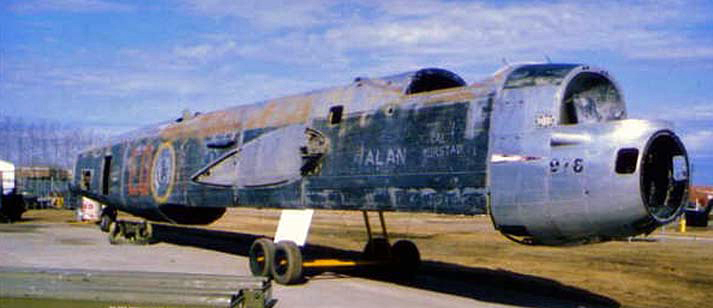 Lancaster
Lancaster  |
Media
|
Media
 Lancaster
Lancaster  |
Media
|
Media

|
1947 was the end; the end of the fourth largest air force in the world. 1947 was the year when the Royal Canadian Air Force reduced its wartime air armada to the level of a merciful peace keeping force. Bombers were no longer needed and trainers were selling for as little as fifty dollars each! 1947 became the year of the enterprising farmer. |
|
Victor Leonhardt, a farmer in the Drumheller area, had started collecting "Barnyard Bombers" in 1946 with Avro Anson JS119; four more followed soon after. Then, on January 22 1947, there was another collection of aircraft being auctioned; not trainers this time, but huge four-engined bombers...Lancasters! On that winter's morning, KB796, KB834, KB941, KB994, and many other combat veterans and new machines alike stood, awaiting their doom. Mr. Leonhardt had bids on two aircraft; KB941 and KB994.
In April 1945, KB941 had arrived in England after being ferried from Canada; KB994 arrived one month later. After the turrets were fitted at a Maintenance Unit, KB941 joined 420 Squadron at Tholthorpe Yorkshire, where it became PT-U. '941 returned to Canada in June 1945 and was put into storage at Pearce, Alberta. KB994 went to 408 Squadron at Linton-On-Ouse, also in Yorkshire. '994 became EQ-K and returned to Canada on July 17 1945, before being put into storage at Claresholm, about twenty miles from Pearce. Both aircraft were ferried to Penhold for disposal shortly before the auction.
As with the five Ansons, Mr. Leonhardt became the owner of both KB941 and KB994, after paying a mere three hundred and fifty dollars each. The next problem was moving the aircraft from Penhold to Drumheller, a distance of over ninety miles by road. The aircraft were in flying condition, but the tenderers had to sign a form stating that none of the parts auctioned would be used on flying aircraft. The Leonhardts were planning to move the aircraft on the ice covering the Red Deer River, but the winter of '47 had been fairly mild and the ice wasn't thick enough, so eventually the aircraft arrived in Drumheller after being towed on their own wheels with the tail-wheel in the back of a truck!
While in Drumheller, both aircraft had their wings removed and parts found their way onto tractors and into clotheslines! During the 1960's, the Leonhardts moved from Drumheller but the family, particularly Mrs. Leonhardt, couldn't bear to leave the Lancasters behind. Needless to say, the fuselage of '994 and centre of '941 followed the Leonhardts another hundred and fifty miles to a farm west of Pigeon Lake. There, more parts went missing, more parts were sold, and more parts were used on the farm.
In 1969, Dr. Ernie Johnson of Calgary bought the nose of KB994 to go on KB976. Later, both KB976 and KB994 were bought by Neil Menzies, and when '976 went to Scotland, more parts of '994 were removed. KB994 had many visitors while it sat in the Leonhardt's yard. Many ex-air force personnel have been to reminisce and many enthusiasts came (and went) planning the restoration of '994, including a couple who asked how often the Leonhard's flew the plane! There were many dreams of "saving" KB994, but it wasn't until July 1984 that anyone took over from Victor and Elsie Leonhardt.
During April of 1984, Phil Nelson, of the Canadian Warplane Heritage Museum, mentioned to Master Warrant Officer Joe Drouin, of 408 Tactical Helicopter Squadron, that Jon Spinks knew the location of an ex-408 Squadron Lancaster, and as a reunion of 408 Squadron was planned in July, it might be an idea to try to get the Lancaster. MWO Drouin learned from Mr. Spinks that KB994 belonged to Niel Menzies, but was still located on Victor Leonhardt's farm at Pigeon Lake. MWO Drouin contacted Mr. Leonhardt and Mr. Menzies, with the result that Mr. Menzies very generously donated KB994 to the newly established 408 Squadron Museum.
On July 21, members of 408 Squadron travelled to Pigeon Lake to prepare KB994 to fly again. Debris was removed from the inside, and the fuselage was moved onto open ground; '994 would make a test flight on the 25th and then would fly onto Canadian Forces Base Edmonton on the 26th. During the morning of the 25th, 447 Squadron sent a Chinook Helicopter to Pigeon Lake, slings were slung, and KB994 flew for the first time in thirty-seven years. Take-off went well, but there was a problem landing; the skids in the bomb bay did not reach out past the fuselage, with the result that the Lancaster rolled down a hill! Fortunately, there was no structural damage but the canopy was destroyed. Finally, July 26 arrived. 447 sent a Chinook out to Pigeon Lake again and the Lancaster was placed upright on longer skids that would prevent any rolling. As the Lancaster came into view at C.F.B. Edmonton, the Chinook was moving at a steady thirty knots, and '994 resembled a very large pendulum. Only later was it learned the Chinook was having engine trouble and nearly jettisoned the Lancaster! At about 2:30, KB994 landed for the last time, at her new home.
Having a wingless, tailess, engineless, noseless, fuselage will present great problems to the members of 408's Museum, but they do have the resources of the military, and as the Canadian Armed Forces maintained Lancs twenty years ago, there should be no reason why KB994 shouldn't be restored to her former glory in the squadron she served with thirty-nine years ago.